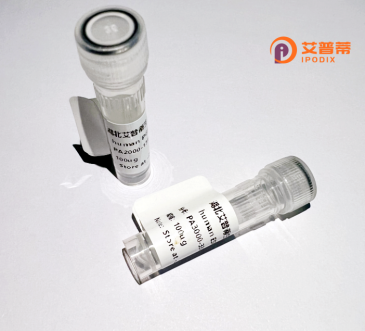
| 纯度 | >90%SDS-PAGE. |
| 种属 | Human |
| 靶点 | POU3F3 |
| Uniprot No | P20264 |
| 内毒素 | < 0.01EU/μg |
| 表达宿主 | E.coli |
| 表达区间 | 1-500 aa |
| 活性数据 | MATAASNPYL PGNSLLAAGS IVHSDAAGAG GGGGGGGGGG GGGAGGGGGG MQPGSAAVTS GAYRGDPSSV KMVQSDFMQG AMAASNGGHM LSHAHQWVTA LPHAAAAAAA AAAAAVEASS PWSGSAVGMA GSPQQPPQPP PPPPQGPDVK GGAGRDDLHA GTALHHRGPP HLGPPPPPPH QGHPGGWGAA AAAAAAAAAA AAAAHLPSMA GGQQPPPQSL LYSQPGGFTV NGMLSAPPGP GGGGGGAGGG AQSLVHPGLV RGDTPELAEH HHHHHHHAHP HPPHPHHAQG PPHHGGGGGG AGPGLNSHDP HSDEDTPTSD DLEQFAKQFK QRRIKLGFTQ ADVGLALGTL YGNVFSQTTI CRFEALQLSF KNMCKLKPLL NKWLEEADSS TGSPTSIDKI AAQGRKRKKR TSIEVSVKGA LESHFLKCPK PSAQEITNLA DSLQLEKEVV RVWFCNRRQK EKRMTPPGIQ QQTPDDVYSQ VGTVSADTPP PHHGLQTSVQ |
| 分子量 | 50.3 kDa |
| 蛋白标签 | His tag N-Terminus |
| 缓冲液 | PBS, pH7.4, containing 0.01% SKL, 1mM DTT, 5% Trehalose and Proclin300. |
| 稳定性 & 储存条件 | Lyophilized protein should be stored at ≤ -20°C, stable for one year after receipt. Reconstituted protein solution can be stored at 2-8°C for 2-7 days. Aliquots of reconstituted samples are stable at ≤ -20°C for 3 months. |
| 复溶 | Always centrifuge tubes before opening.Do not mix by vortex or pipetting. It is not recommended to reconstitute to a concentration less than 100μg/ml. Dissolve the lyophilized protein in distilled water. Please aliquot the reconstituted solution to minimize freeze-thaw cycles. |
1. **"Cloning and functional characterization of human POU3F3: A transcription factor involved in neural differentiation"**
- *Author: Li Y, et al.*
- 摘要:该研究克隆了人源POU3F3基因,通过大肠杆菌表达系统获得重组蛋白,并验证其在小鼠胚胎干细胞神经分化中的作用,揭示其通过调控靶基因Sox2促进神经前体细胞形成。
2. **"Structural insights into POU3F3-DNA binding and its role in glioblastoma progression"**
- *Author: Wang X, et al.*
- 摘要:解析重组人POU3F3蛋白的晶体结构,阐明其特异性结合DNA的机制;功能实验表明其高表达与胶质母细胞瘤侵袭性相关,可能通过激活MAPK通路驱动肿瘤恶化。
3. **"Recombinant POU3F3 synergizes with OCT4 to reprogram somatic cells into pluripotent states"**
- *Author: Kim J, et al.*
- 摘要:利用昆虫细胞体系表达并纯化高活性重组POU3F3蛋白,发现其与OCT4协同可提高体细胞重编程效率,为诱导多能干细胞技术提供新策略。
4. **"POU3F3 regulates neurotransmitter gene expression and its recombinant protein rescues neuronal deficits in zebrafish"**
- *Author: Chen L, et al.*
- 摘要:在HEK293细胞中表达重组人POU3F3.证明其通过调控多巴胺合成酶基因TH的表达影响神经元功能,并在斑马鱼模型中逆转基因敲除导致的运动缺陷。
Recombinant human POU3F3 protein, also known as Brain-1 (Brn-1), belongs to the POU transcription factor family characterized by a conserved POU DNA-binding domain. This domain comprises two subregions: a POU-specific domain (POU_S) and a POU homeodomain (POU_H), enabling sequence-specific DNA binding and regulatory interactions. POU3F3. encoded by the *POU3F3* gene on chromosome 2q12.1. is primarily expressed in neural tissues and plays critical roles in embryonic development, particularly in the differentiation and maintenance of neurons and glial cells.
Functionally, POU3F3 regulates gene expression networks involved in neurogenesis, cell cycle exit, and neuronal maturation. Studies highlight its importance in central nervous system development, including the maintenance of neural stem cells and cortical layer formation. Dysregulation of POU3F3 has been implicated in neurological disorders and cancers, such as glioblastoma and colorectal carcinoma, where its aberrant expression correlates with tumor progression or poor prognosis.
Recombinant POU3F3 protein, produced via heterologous expression systems (e.g., *E. coli* or mammalian cells), retains DNA-binding activity and is widely used to study transcriptional mechanisms, protein-DNA interactions, and potential therapeutic targets. Recent research also explores its extracellular roles, as POU3F3 has been detected in serum exosomes, suggesting utility as a non-invasive biomarker for early cancer detection.
×